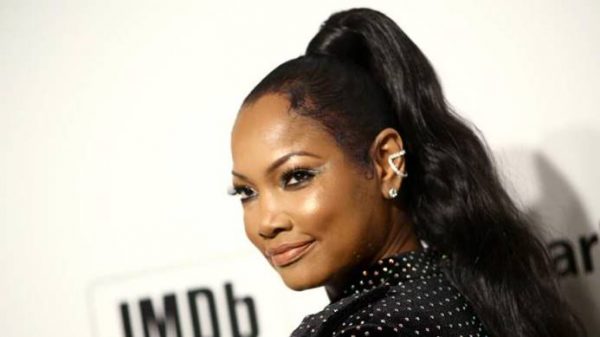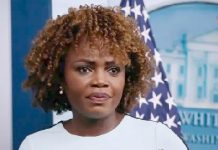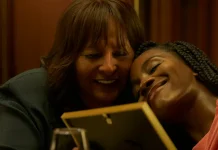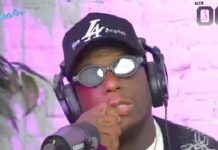
*Playwright and actress Anna Deavere Smith’s HBO special Notes From the Field debuts tonight (Feb. 24) at 8 p.m. ET. Best known for her brand of documentary-style theater and her one-person shows, Smith has created Notes From the Field as a follow-up to her 2016 off-Broadway play of the same name, which was inspired by her school-to-prison social justice initiative, The Anna Deavere Smith Pipeline Project.
The documentary was championed by the late film director and producer Jonathan Demme, who came to see the show while it was in previews and told Smith that he wanted to make the play into a film. “Jonathan said to me, ‘I want this to be the last work I do.’ I didn’t know when he said that he was ill,” Smith recalls.
Like Ava DuVernay’s 13th documentary, Notes From the Field addresses the issues of the prison industrial complex, mass incarceration and why America has the highest prison rate in the world. In Notes From the Field, which was directed by Kristi Zea and filmed over two days at a New York City soundstage, Smith brilliantly creates eighteen riveting portraits of real individuals, whose words and experiences depict a direct correlation between race, education and poverty and how it impacts people of color.
Smith, a Baltimore native, interviewed more than two hundred and fifty people for the project, including inmates, teachers, students, politicians, activists, family members and members of the community, among others on varied issues ranging from gun violence to mental health issues. The film gives voice to the events surrounding the highly publicized Freddie Gray case, the Charleston Massacre, the removal of Confederate Flag, civil rights icon John Lewis, and other unpublicized stories that are often absent from the twenty-four-hour news cycle.
Smith will also star in Shonda Rhimes’ upcoming new show, For the People, which is Rhimes’ last show on the ABC television network. The series debuts March 13th. Smith also plays the mother of Rainbow Johnson, portrayed by Tracee Ellis Ross, on ABC’s sitcom Black-ish.
[This interview has been edited and condensed for clarity].

Gwendolyn Quinn: Tell me about “Notes From the Field.”
Anna Deavere Smith: “Notes From the Field” is part of the Anna Deavere Smith school-to-prison pipeline project. The mission of the project is to raise awareness about how poverty is affecting many children and how schools don’t have what they need to take care of the kids who often end up on the road to prison and cycles of mass incarceration. My focus is on the kids.
GQ: How involved were you in the creative process of the film?
ADS: I was very involved in the creative process. I spent this past summer [2017] with the editor, Paul Snyder, and the director, Kristi Zea. It was an amazing experience. In a way unlike what I do when I’m writing a play. I had two hundred and fifty interviews and more than three hundred hours of material. Our job was to get it down to a show that was an hour and forty-five minutes long. The amazing thing is that when Jonathan [Demme] passed away, his team—who were slated to work on the film—are the same people who had worked with him for years, and they were still committed to the project. In many ways, they felt that they were doing it as a part of his legacy.
GQ: What were the creative differences between the film and the play?
ADS: The backdrops. Again, I credit Kristi [Zea] for that, I think it’s relevant. She was Jonathan’s production designer for many of his films. This is only the second film she’s directed. I originally met her when she was a production designer for the movie “Philadelphia,” in which I had a small role. She was also Martin Scorsese’s production designer. The whole concept, when you saw the play, there were slides used in the production [backdrop], in the film she wanted to make the world behind the performances larger. Even if you try to do that with the play, I don’t think it would look as great as it does on film. On screen, it’s all images. I’m an image with another image. A theater experience doesn’t allow for close-ups.

GQ: What did you learn from the filming of “Notes From the Field” that you will probably incorporate into future theater productions?
ADS: When I’m on stage, I don’t see myself, and I don’t film myself in rehearsal. I’m very conscious of everything because of how I study a character, a person. Seeing it on film makes me want to be better. The other thing that happened, which was so exciting, was that I’ve always wanted to have live musicians involved with my work. Bassist Marcus Shelby, who was in the play, is also in the film. In the past, I’ve only been able to work with musicians experimentally.
In “Notes From the Field,” the soundtrack underneath featured some beautiful Broadway singers, including Lisa Fischer, who has sung with the [Rolling] Stones and Tina Turner. And we also worked with a young trumpet player named Riley Mulherkar out of [the] Juilliard [School of Music].
I would like to proceed with my desire to put music in my plays. Producers don’t want to pay for it, and theater directors believe that’s their jurisdiction, so for me to tell a theater director about music would be like a theater director telling me how to read a line. Before I had a director for the play, Marcus was the first artist that I worked with on the pipeline project. Working with Marcus and the glee of being in the studio with all those incredible singers was exciting, and it brings another emotionality to the film that I can’t possibly do myself.

GQ: I never imagined that Native Americans were subject to the school-to-prison pipeline problem, too. Can you talk about the Native American portraits?
ADS: This is one of the biggest gifts that I had in this process. I think all of us as creative people go through different stages in our work. And in my work, there’s this time where I’m doing research, and I don’t know what it’s going to be, I don’t know if I like it, and I don’t know if I want to stick with it. I almost never abandon a project, but it was like, “What is this? What are they talking about?”
When I met the people from the Yurok tribe is when I fell in love with the project. I was like, “Oh, I’m in, and I’m bringing this full circle. Nothing’s stopping me.” Even though I’ve read about how dire the situation is for Native Americans; I had no idea.
I’ve written about eighteen plays like this, and I have tried to include Native Americans in my work, and they were hesitant, and some refused to talk to me with a very legitimate reason, which is this is their story, it’s not my story. I said “OK.” But with this tribe [Yurok], what I was able to experience is the combination of their nobility, their sense of place that they belong there, that they belong on the river, that they belong in the forest. [Yurok] is a river tribe, a salmon fishing tribe.
But that juxtaposes an incredible profound sense of loss. As you might know, poverty is dire, the drug addiction, methamphetamine is incredible, and no psychiatric services. Every year they are fighting to keep their programs alive. You can’t say whose story is worse, but it was powerful to be in that particular combination of nobility and loss.
GQ: Which voice/dialect was the most challenging?
ADS: Every interview had a different effect, and some of that has to do with my experience while I’m trying to learn it. That kid who talks about Steven Campos, the guy who put a baby in a microwave, that [dialect] was very hard to learn; not because the story is so dark, but the way he talked was hard to learn, especially his excessive use of the “F” word or what some people call the “F-bomb.” The other person who was challenging to learn was Allen Bullock [from Baltimore], who comes early in the film and smashes up a police car.
Then, there’s that historical story that [Congressman] John Lewis told. And Bree Newsome, the sister that climbed the flagpole in Charleston, South Carolina, to remove the Confederate flag.
GQ: Why did you open the film with the Freddie Gray story?
ADS: Kevin Moore [the videographer of the Freddie Gray story], who speaks right after Sherrilyn Ifill [President and Director-Counsel of the NAACP Legal Defense Fund] puts us in the moment, a specific moment in history, and it’s the moment of videos. We were driving down the street [in Baltimore], and one of the kids working with me said, “Hey, I think that’s the guy who filmed the beating of Freddie Gray.” We stopped the van, jumped out and got this guy [Kevin Moore] to talk to us.
When he says, the camera is the only weapon that we have to protect ourselves that’s not illegal. I’m like, “Ooh, yeah.” At the time [2015], I was still doing my interviews. Michael Brown was killed in Ferguson in August 2014, and the Black Lives Matter [movement] was getting bigger and bigger, I felt that was a mark of the moment, a gesture of the moment. The camera is the only weapon that we have.
GQ: In the Freddie Gray case, six police officers were not convicted of any charges. What were your thoughts on the trial?
ADS: I think the people who know about politics knew. Kurt Schmoke, who was a former mayor of Baltimore, is somebody who I talked to before the verdict. He said, “I’m worried because it’s tough to put police officers in jail.”
On Shonda Rhimes’ new television show, “For the People,” it’s about public defenders and assistant U.S. Attorneys. We did not have public defenders in the United States of America until the 1960s. Imagine what poor people had to go through. It blows my mind. The law is always on the side of the powerful, and historically it’s difficult to take cops to jail.
GQ: Do you feel any improvements have been made to the school-to-prison pipeline? Do you think Ava DuVernay’s documentary “13th” made an impact; and Angela Davis’ longtime commitment to addressing the issues of the criminal justice system?
ADS: I think Ava DuVernay, Ta-Nehisi Coates, and Michelle Alexander have all made an enormous contribution and raising awareness. Also, helping white people who care, understand yet another dimension of our race, problem, and challenge. Of course, Angela [Davis] has been out there looking at prisons and mass incarceration for decades. Back in the late ‘80s, early ‘90s, she asked me to come to one of the prisons she was working in San Francisco. She’s been on the frontlines for a long time. She’s a living bedrock of this movement and still very inspiring.
It’s too bad that those realities are overshadowed by the concerns that we have in the world right now. I came out of this project amazed and excited about the different ways that people are working together.

Gwendolyn Quinn is an award-winning media strategist and consultant with a career spanning more than 25 years. She is a contributor to NBCNews.com, BlackEnterprise.com, and HuffPost, among others.
We Publish News 24/7. Don’t Miss A Story. Click HERE to SUBSCRIBE to Our Newsletter Now!





